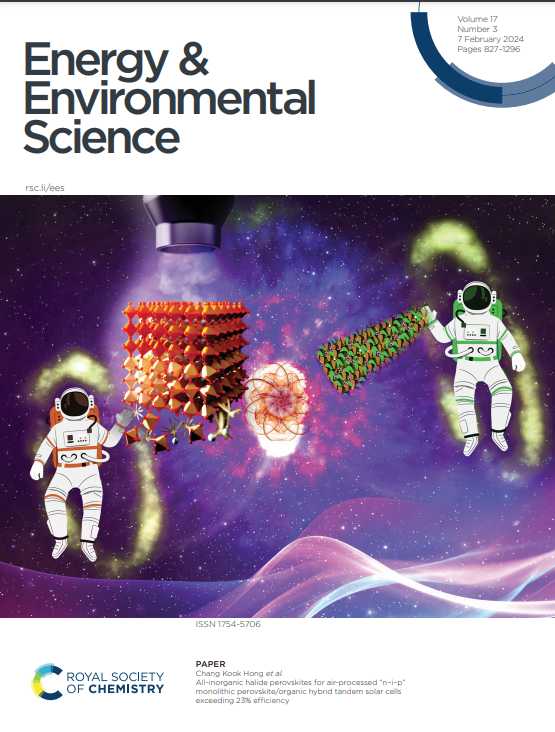Unlocking high-current-density nitrate reduction and formaldehyde oxidation synergy for scalable ammonia production and fixation
IF 32.4
1区 材料科学
Q1 CHEMISTRY, MULTIDISCIPLINARY
引用次数: 0
Abstract
Nitrate electroreduction to ammonia holds great promise in sustainable green ammonia synthesis, yet faces the dearth of competent electrocatalysts adapting varying nitrate concentrations, and the inadequate ammonia fixation. Herein, we present a high-performance Ag single-atom-decorated Cu2O nanowires catalyst (Ag1@Cu2O) that exhibits concentration-universal high-rate nitrate reduction, achieving >90% to near-unity ammonia Faradaic efficiency (FE) across nitrate concentrations from 0.01 to 0.5 M. Notably, at 0.5 M nitrate concentration, it attains a two-ampere-level current density (2.3 A cm−2) at ‒1 V vs. RHE, resulting in a leading ammonia yield rate of 184.4 mgNH3 h−1 cm−2. In-situ studies combined with theoretic calculations elucidate an Ag-Cu inter-site synergistic catalytic mechanism, in which single-atom Ag serves as an accelerator for active hydrogen generation and stabilization on Cu sites to boost the hydrogenation kinetics of N-containing intermediates, thus smoothing the energy barriers for ammonia production via the favorable *NHO pathway. Additionally, Ag1@Cu2O demonstrates near-unity formate FE for formaldehyde oxidation, reaching a 300 mA cm−2 current density at merely 0.31 V vs. RHE. Motivated by this exceptional bifunctionality, we demonstrate an innovative tandem electrochemical-chemical strategy for upgrading ammonia into high-value ammonium formate by coupling electrolysis of nitrate reduction and formaldehyde oxidation, followed by straightforward chemical combination and isolation. Practice in a membrane electrode assembly (MEA) electrolysis at 1.6 V for 100 h successfully outputs 10.7 g of high-purity ammonium formate. Furthermore, the commonality of this strategy is validated by application to various nitrate/aldehyde pairs. This work blazes a new trail for scalable, cost- and energy-efficient green ammonia production and fixation from nitrate reduction.解锁高电流密度硝酸盐还原和甲醛氧化协同作用,可扩展氨生产和固定
硝酸盐电还原制氨在可持续的绿色氨合成中具有很大的前景,但面临着缺乏适应不同硝酸盐浓度的合格电催化剂和氨固定不足的问题。在此,我们提出了一种高性能的Ag单原子修饰的Cu2O纳米线催化剂(Ag1@Cu2O),该催化剂表现出浓度通用的高速率硝酸盐还原,在0.01至0.5 M的硝酸盐浓度范围内,达到90%的近单位氨法拉第效率(FE)。值得注意的是,在0.5 M的硝酸盐浓度下,与RHE相比,它在-1 V下获得了2安培级的电流密度(2.3 a cm−2),导致氨的产率达到184.4 mgNH3 h−1 cm−2。原位研究结合理论计算阐明了Ag-Cu位点间协同催化机制,其中单原子Ag作为活性氢生成和Cu位点稳定化的加速器,提高了含n中间体的加氢动力学,从而平滑了通过有利的*NHO途径产生氨的能量障碍。此外,Ag1@Cu2O显示了甲醛氧化的近统一甲酸FE,在仅0.31 V时达到300 mA cm - 2电流密度。在这种特殊的双功能的激励下,我们展示了一种创新的串联电化学-化学策略,通过耦合硝酸还原和甲醛氧化的电解,然后是直接的化学组合和分离,将氨转化为高价值的甲酸铵。实践在膜电极组件(MEA)电解在1.6 V 100小时成功输出10.7 g高纯度甲酸铵。此外,通过应用于各种硝酸盐/醛对,验证了该策略的通用性。这项工作为大规模、低成本和节能的绿色氨生产和硝酸盐还原固定开辟了一条新的道路。
本文章由计算机程序翻译,如有差异,请以英文原文为准。
求助全文
约1分钟内获得全文
求助全文
来源期刊

Energy & Environmental Science
化学-工程:化工
CiteScore
50.50
自引率
2.20%
发文量
349
审稿时长
2.2 months
期刊介绍:
Energy & Environmental Science, a peer-reviewed scientific journal, publishes original research and review articles covering interdisciplinary topics in the (bio)chemical and (bio)physical sciences, as well as chemical engineering disciplines. Published monthly by the Royal Society of Chemistry (RSC), a not-for-profit publisher, Energy & Environmental Science is recognized as a leading journal. It boasts an impressive impact factor of 8.500 as of 2009, ranking 8th among 140 journals in the category "Chemistry, Multidisciplinary," second among 71 journals in "Energy & Fuels," second among 128 journals in "Engineering, Chemical," and first among 181 scientific journals in "Environmental Sciences."
Energy & Environmental Science publishes various types of articles, including Research Papers (original scientific work), Review Articles, Perspectives, and Minireviews (feature review-type articles of broad interest), Communications (original scientific work of an urgent nature), Opinions (personal, often speculative viewpoints or hypotheses on current topics), and Analysis Articles (in-depth examination of energy-related issues).
 求助内容:
求助内容: 应助结果提醒方式:
应助结果提醒方式:


